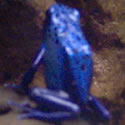Dangerous Frogs: The Blue Poison Dart Frog

Dendrobates azureus
 Habitat
Habitat
The Blue Poison Dart Frog is found only in the southernmost part of Suriname, in South America. It lives in small, isolated tropical forest areas surrounded by dry, prairie-like savannah. It prefers a dark, moist environment, living only near small streams among moss-covered rocks. It typically remains on the ground, but has been found in trees as well. It is very active during the daytime and moves constantly with short leaps. Blue Poison Dart Frogs are solitary animals, interacting with others only during territorial fighting and breeding.
Description
The Blue Poison Dart Frog is multiple colors of blue with an irregular pattern of dark blue and black spots of various sizes speckling its back and head and other parts of its body. The pattern of spots is unique to each frog and thus serves as a fingerprint to distinguish individuals. Some individuals also have a dark blue or black mid-belly stripe.
The skin of the Blue Poison Dart Frog secretes poisons capable of paralyzing or killing predators. Nevertheless, the frog is preyed upon by snakes and large spiders.
The Blue Poison Dart Frog is an insectivore, but it eats noninsect arthropods as well. Its diet consists of ants, beetles, flies, mites, spiders, termites, maggots, and caterpillars. Interestingly, the poisons in its skin occur in high concentrations in its prey, especially in ants. When the frog eats its prey, these toxic compounds are absorbed into the frog’s skin, giving it its defense mechanism. In captivity, the frog loses its poisonous properties unless its diet includes these same toxic compounds. Tadpoles feed on their mother’s unfertilized eggs.